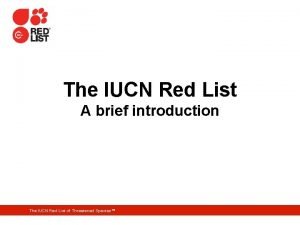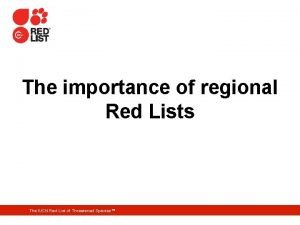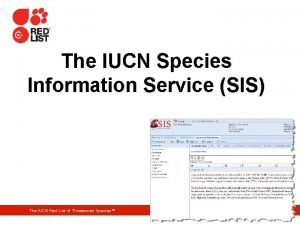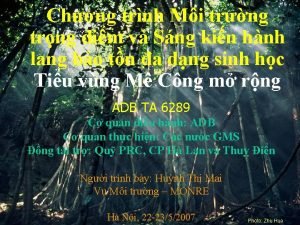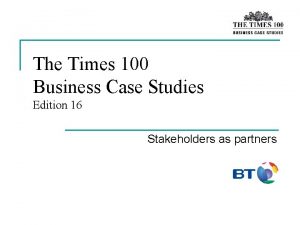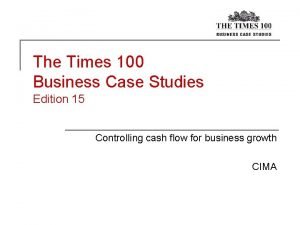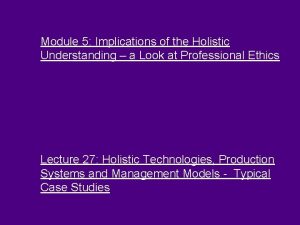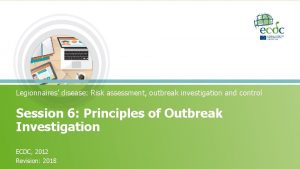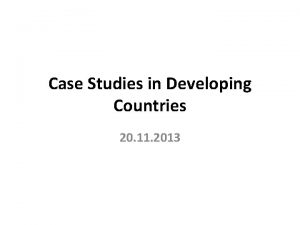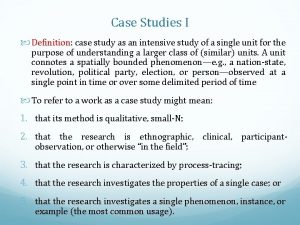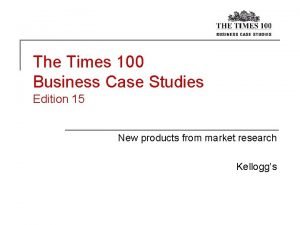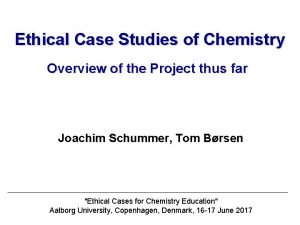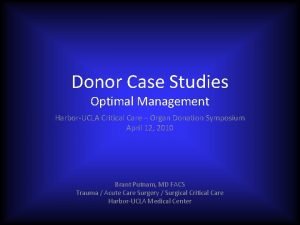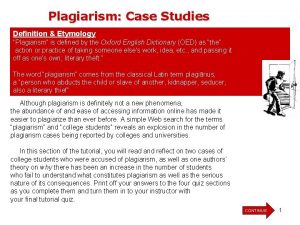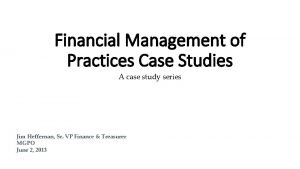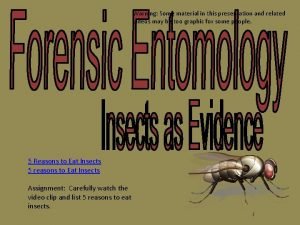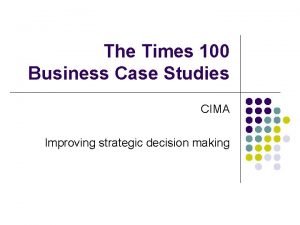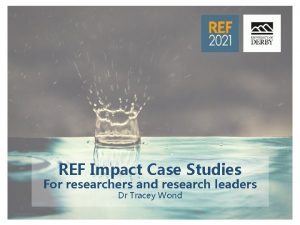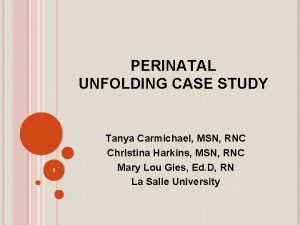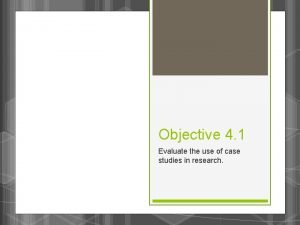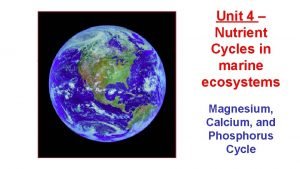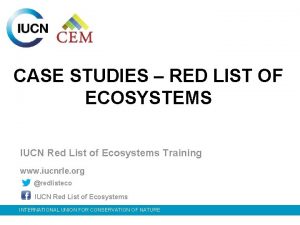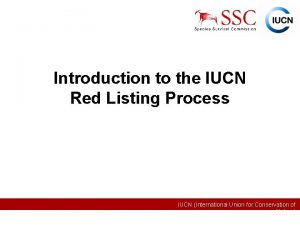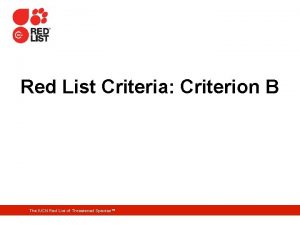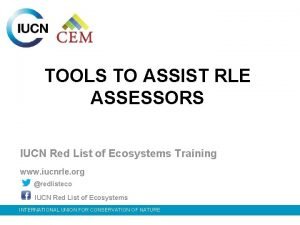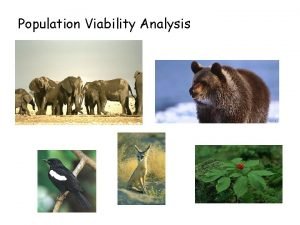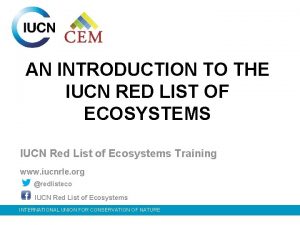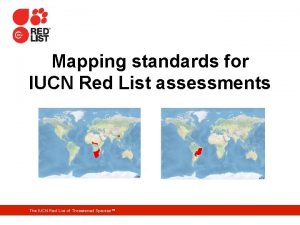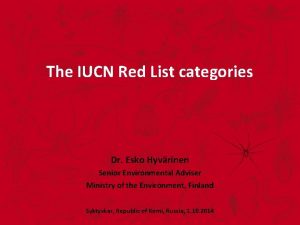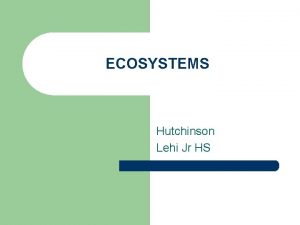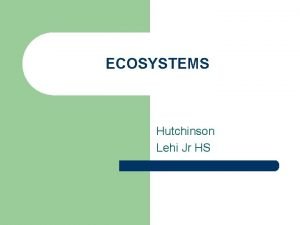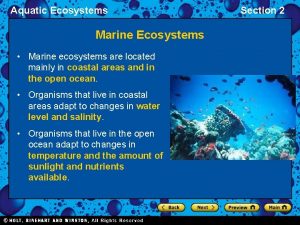CASE STUDIES RED LIST OF ECOSYSTEMS IUCN Red














































- Slides: 46

CASE STUDIES – RED LIST OF ECOSYSTEMS IUCN Red List of Ecosystems Training www. iucnrle. org @redlisteco IUCN Red List of Ecosystems INTERNATIONAL UNION FOR CONSERVATION OF NATURE

Assessing ecosystem change: Criteria Ecosystem distribution function C Degradation of abiotic environment A Declining distribution Threatening processes Risk of loss of characteristic native biota B Restricted distribution Threatening processes D Altered biotic processes E Quantitative risk analysis Each criterion has sub-criteria that represent different measures of risk, e. g. , different timeframes or distribution metrics

https: //iucnrle. org/assessments/

https: //iucnrle. org/assessments/

Example: Coorong Lagoon, Australia Keith et al. , 2013 / Contribution by Rebecca Lester et Peter Fairweather

Example: Coorong Lagoon, Australia Keith et al. , 2013.

Example: Coorong Lagoon, Australia Keith et al. , 2013.

Example: Coorong Lagoon, Australia § § § State & transition framework 8 states (healthy & unhealthy) Transition to ‘unhealthy’ states across the region collapsed § Interactions between water levels, flow and salinity

Example: Coorong Lagoon, Australia Criterion A: Reduction in geographic distribution § A 1: Past (past 50 y) No declines in the past 50 years

Example: Coorong Lagoon, Australia Criterion A: Reduction in geographic distribution § A 1: Past (past 50 y) No declines in the past 50 years § A 2: Future (next 50 y) Extent very unlikely to decline in the future. Low barrage flows would be compensated by seawater flowing in through the Murray Mouth

Example: Coorong Lagoon, Australia Criterion A: Reduction in geographic distribution § A 1: Past (past 50 y) No declines in the past 50 years § A 2: Future (next 50 y) Extent very unlikely to decline in the future. Low barrage flows would be compensated by seawater flowing in through the Murray Mouth § A 3: Historic (since 1750) No estimates of historic extent available

Example: Coorong Lagoon, Australia Criterion B: Restricted geographic distribution § B 1: Extent of occurrence - EOO 121 km long, average width of 1. 9 km EOO = 205 km 2 (< 2000 km 2) - Evidence of increasing salinity since 1996, with extremely high salinities observed since 2006. - Further increases in salinity forecast under median and dry future climate projections. - One location.

Example: Coorong Lagoon, Australia Criterion B: Restricted geographic distribution § B 2: Area of occupancy - AOO = 17 - Evidence of increasing salinity since 1996, with extremely high salinities observed since 2006. - Further increases in salinity forecast under median and dry future climate projections. - One location.

Example: Coorong Lagoon, Australia Criterion B: Restricted geographic distribution § B 3: Small number of locations The Coorong occupies a single location and is prone to the effects of both human activities (i. e. water extraction and changes to flow regimes upstream) and stochastic events (e. g. drought) simultaneously.

Example: Coorong Lagoon, Australia Criterion B: Restricted geographic distribution § B 1 a, b, c: Extent of occurrence § B 2 a, b, c: Area of occupancy § B 3: Small number of locations

Example: Coorong Lagoon, Australia Criterion C: Environmental degradation Two main components in the abiotic environment reduce habitat quality for characteristic biota of the Coorong ecosystem: small volumes of fresh water delivered to the Coorong via the River Murray, and the extreme salinity of the South Lagoon Variables (threshold) Average volumes of annual barrage flows (1000 μS cm-1) Average annual salinity (117 g L-1) Maximum annual salinity (100 g L-1)

Example: Coorong Lagoon, Australia Criterion C: Environmental degradation Variables (threshold) Average volumes of annual barrage flows (1000 μS cm-1) Average annual salinity (117 g L-1) Maximum annual salinity (100 g L-1) Barrage flows decline affect the whole Coorong (extent of impact is always 100%).

Example: Coorong Lagoon, Australia Criterion C: Environmental degradation § C 1: Past (past 50 y) Flows below threshold in 36% of years and this affects 100% of ecosystem extent.

Example: Coorong Lagoon, Australia Criterion C: Environmental degradation § C 1: Past (past 50 y) Flows below threshold in 36% of years and this affects 100% of ecosystem extent. § C 2: Future (next 50 y) Different climate scenarios used. Median Future: Flows below threshold in 45% of years and this affects 100% Dry Future: Flows below threshold in 86% of years and this affects 100%

Example: Coorong Lagoon, Australia Criterion C: Environmental degradation § C 1: Past (past 50 y) Flows below threshold in 36% of years and this affects 100% of ecosystem extent. § C 2: Future (next 50 y) Flows below threshold in 86% of years and this affects 100% of ecosystem extent. § C 3: Historic (since 1750) No estimates of historic change available.

Example: Coorong Lagoon, Australia Criterion D: Disruption of biotic processes Ruppia megacarpa and R. tuberosa are a critical component in the structure and functioning of the Coorong: provision of food and habitat for birds, fish and macroinvertebrates + modify physical and biogeochemical processes in the lagoon. Variables (threshold) Spatial coverage of Ruppia spp. (abundance = 0) estimates of historic change available.

Example: Coorong Lagoon, Australia Criterion D: Disruption of biotic processes § D 1: Past (past 50 y) Ruppia megacarpa once dominated the Murray Mouth and North Lagoon. Not observed in the Coorong since the mid-1990 s. Ruppia tuberosa has traditionally dominated in the South Lagoon. 1999, present in 33 to 91% samples from four sites 2005, absent from two sites 2008, absent from the South Lagoon Extent and severity of the decline in both Ruppia species > 80%

Example: Coorong Lagoon, Australia Criterion D: Disruption of biotic processes § D 1: Past (past 50 y) Extent and severity of the decline in both Ruppia species > 80% § D 2: Future (next 50 y) No simulations for future declines in R. tuberosa exist, while R. megacarpa is already extinct from the system, and no evidence of ecolonisation has been observed

Example: Coorong Lagoon, Australia Criterion D: Disruption of biotic processes § D 1: Past (past 50 y) Extent and severity of the decline in both Ruppia species > 80% § D 2: Future (next 50 y) No simulations for future declines in R. tuberosa exist, while R. megacarpa is already extinct from the system, and no evidence of ecolonisation has been observed § D 3: Historic (since 1750) No estimate of long-term changes biotic interactions exists.

Example: Coorong Lagoon, Australia Criterion E: Quantitative risk analysis § State & transition framework § 8 states (healthy & unhealthy) § Transition to ‘unhealthy’ states across the region collapsed § Interactions between water levels, flow and salinity

Example: Coorong Lagoon, Australia Criterion E: Quantitative risk analysis § Modelled hundreds of future scenarios of water extraction & climate change § Probability of collapse: 30 -100% in 50 years ( - )

Example: Coorong Lagoon, Australia Criterion Subcriterion 1 A LC B CR C VU D CR Subcriterion 2 Subcriterion 3 LC DD EN VU CR DD DD DD E Overall CR(EN-CR) CR B 1 a, b, c, C 2, E

Example: Mountain ash forest § Dominated by Eucalyptus regnans, the world’s tallest flowering plant. § Key features - Large trees (>50 m), dense understory - Diverse tree-dependent fauna - Temperature and precipitation determine distribution (‘wet and cool’) § Key processes – Recurring wildland fires – Timber harvest Burns et al. , 2015

Example: Mountain ash forest

Example: Mountain ash forest Criterion A: Reduction in geographic distribution § A 1: Past (past 50 y) 3 Victorian Government spatial layers: (i) the Statewide Forest Resource Inventory dataset; (ii) the Logging History dataset; (iii) the Ecological Vegetation Classes dataset. - Current distribution estimated at 156 700 ha - 96. 4% on public land (stable land tenure) - Assumed no change in distribution since 1964

Example: Mountain ash forest Criterion A: Reduction in geographic distribution § A 1: Past (past 50 y) Current distribution estimated at 156 700 ha. No change since 1964 § A 2: Future (next 50 y) 96. 4% on public land (stable land tenure). No change predicted for 2064.

Example: Mountain ash forest Criterion A: Reduction in geographic distribution § A 1: Past (past 50 y) Current distribution estimated at 156 700 ha. No change since 1964 § A 2: Future (next 50 y) 96. 4% on public land (stable land tenure). No change predicted for 2064 § A 3: Historic (since 1750) Models suggest a decrease from 183. 000 ha in 1750 to 180. 000 ha in 2014

Example: Mountain ash forest Criterion B: Restricted geographic distribution § B 1 c: Extent of occurrence EOO= 11, 000 km 2; ≤ 2 locations

Example: Mountain ash forest Criterion B: Restricted geographic distribution § B 2: Area of occupancy 96 occupied cells, 23 ≤ 1 km 2 AOO = 76

Example: Mountain ash forest Criterion B: Restricted geographic distribution § B 1 c: Extent of occurrence EOO= 11, 000 km 2; ≤ 2 locations § B 2: Area of occupancy AOO = 76 § B 3: Number of locations ≤ 2 locations; prone to collapse within short period

Example: Mountain ash forest Criterion C: Environmental degradation Collapse: 100% of area where ecosystem occurs no longer bioclimatically suitable § C 1: Past (past 50 y) Insufficient temperature and precipitation data since 1964

Example: Mountain ash forest Criterion C: Environmental degradation Collapse: 100% of area where ecosystem occurs no longer bioclimatically suitable § C 1: Past (past 50 y) Insufficient temperature and precipitation data since 1964 § C 2: Future (next 50 y) Used IPCC emission scenarios to calculate the predicted extent loss 45% reduction (extent), 100% relative severity

Example: Mountain ash forest Criterion C: Environmental degradation Collapse: 100% of area where ecosystem occurs no longer bioclimatically suitable § C 1: Past (past 50 y) Insufficient temperature and precipitation data since 1964 § C 2: Future (next 50 y) Used IPCC emission scenarios to calculate the predicted extent loss 45% reduction (extent), 100% relative severity § C 3: Historic (since 1750) Insufficient temperature and precipitation data since 1964

Example: Mountain ash forest Criterion D: Disruption of biotic processes Collapse: less than 1% old growth forest remains Used long-term field survey data, fire-history records and mapped oldgrowth forest. Investigated 39 scenarios based on varying harvesting and fire regimes § D 1: Past (past 50 y) Estimated a change in the number of hollow-bearing trees (using oldgrowth as a surrogate) ≥ 80% relative severity (averaged across 100% extent)

Example: Mountain ash forest Criterion D: Disruption of biotic processes Collapse: less than 1% old growth forest remains Used long-term field survey data, fire-history records and mapped oldgrowth forest. Investigated 39 scenarios based on varying harvesting and fire regimes § D 1: Past (past 50 y) Estimated a change in the number of hollow-bearing trees (using oldgrowth as a surrogate) ≥ 80% relative severity (averaged across 100% extent) § D 2: Future (next 50 y) Projected decline of ≥ 78% with ≥ 100% relative severity (averaged across 100% extent of the ecosystem

Example: Mountain ash forest Criterion D: Disruption of biotic processes Collapse: less than 1% old growth forest remains Used long-term field survey data, fire-history records and mapped oldgrowth forest. Investigated 39 scenarios based on varying harvesting and fire regimes § D 1: Past (past 50 y) Estimated a change in the number of hollow-bearing trees (using oldgrowth as a surrogate) ≥ 80% relative severity (averaged across 100% extent) § D 2: Future (next 50 y) Projected decline of ≥ 78% with ≥ 100% relative severity (averaged across 100% extent of the ecosystem § D 3: Historic (since 1750) Decline with ≥ 99% relative severity over 100% extent

Example: Mountain ash forest Ecosystem collapse: when Hollow Bearing Trees HBT<1/ha Oldgrowth forest >1 HBT/ha <1 year >120 years Regrowth forest <1 HBT/ha x Model calculates future (50 yrs) HBT density as a function of: – Initial HBT density – Probability of fire – Probability of logging – Projected climate suitability Burns et al. , 2015 39 modelled scenarios of logging and fire under future climate – Logging: none/regrowth only/unrestricted – Fire: none/small/medium/large extent 10, 000 simulations

Example: Mountain ash forest Results: § All scenarios: ≥ 92% chance of reaching a collapsed state (<1 HBT/hectare) in 50 years § Scenarios with unrestricted logging, medium and large fires produced most severe effects

Example: Mountain ash forest Criterion Subcriterion 1 Subcriterion 2 Subcriterion 3 A LC LC LC B EN LC VU C DD VU DD D CR CR CR E CR Overall CR D 1, D 2, D 3, E A single metric may not provide a detailed picture of the status of a given ecosystem! Ecosystems with little change in extent may be experiencing severe functional changes.

Contact § If you want to contact us, write us to: redlistofecosystems@gmail. com § Join our forum of evaluators in: iucn-red-list-of-ecosystems@googlegroups. com § Follow us on: IUCN Red List of Ecosystems @redlisteco @redlist_of_ecosystems IUCN Red List of Ecosystems

Thank you to our donors, supporters & partners
 Functions of iucn
Functions of iucn Iucn red list
Iucn red list Iucn red list
Iucn red list Red list of iucn
Red list of iucn Best case worst case average case
Best case worst case average case Iucn sis
Iucn sis Iucn kategorien
Iucn kategorien Iucn việt nam
Iucn việt nam Source
Source Paradigm shift from women studies to gender studies
Paradigm shift from women studies to gender studies Advantages of case studies in psychology
Advantages of case studies in psychology Times 100 case studies
Times 100 case studies Times 100 business case studies
Times 100 business case studies Case studies of typical holistic technologies
Case studies of typical holistic technologies Advantages and disadvantages of case control studies
Advantages and disadvantages of case control studies Significant vs important
Significant vs important Gdpr case studies
Gdpr case studies Geography paper 1 case studies aqa
Geography paper 1 case studies aqa Euthanasia case studies
Euthanasia case studies E procurement case studies
E procurement case studies Types of case studies
Types of case studies Define: case study
Define: case study The times 100 business case studies
The times 100 business case studies Nasa case study
Nasa case study Abo discrepancy case studies
Abo discrepancy case studies Chemistry-ethics case studies
Chemistry-ethics case studies Nspe board of ethical review cases
Nspe board of ethical review cases Organ donation case studies
Organ donation case studies Jmp case studies
Jmp case studies Case studies of rtos
Case studies of rtos Ferpa case studies
Ferpa case studies Social engineering case studies
Social engineering case studies Etymology of plagiarism
Etymology of plagiarism Financial management case study
Financial management case study Digital marketing case studies 2012
Digital marketing case studies 2012 Forensic entomology double puzzle answers
Forensic entomology double puzzle answers The times 100 business case studies
The times 100 business case studies Ref impact case studies
Ref impact case studies Tanya carmichael
Tanya carmichael Food safety errors: case studies
Food safety errors: case studies Growth hacking case studies
Growth hacking case studies Exercise #1 – evaluate case studies answer key
Exercise #1 – evaluate case studies answer key Water pollution introduction
Water pollution introduction Magnesium cycle in marine ecosystem
Magnesium cycle in marine ecosystem Lesson outline lesson 2 aquatic ecosystems answer key
Lesson outline lesson 2 aquatic ecosystems answer key Aquatic areas
Aquatic areas Ecosystems examples
Ecosystems examples
